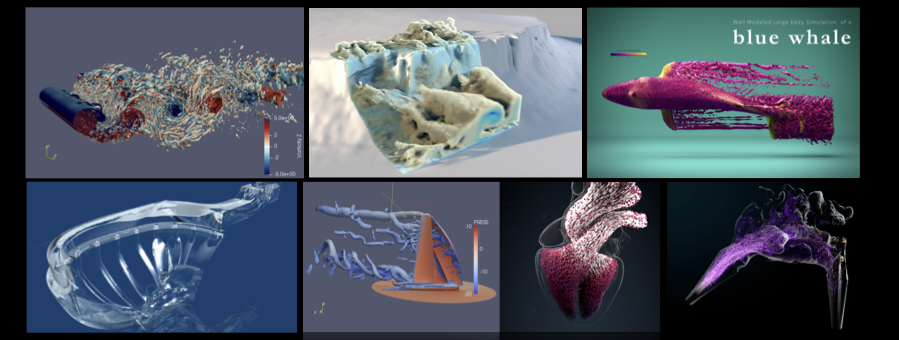
Alya is a simulation code for high performance computational mechanics. Alya solves coupled multiphysics problems using high performance computing techniques for distributed and shared memory accelerated supercomputers, together with vectorization and optimization at the node level.
Summary
Alya is a high performance computational mechanics code to solve complex coupled multi-physics / multi-scale / multi-domain problems, which are mostly coming from the engineering realm. Among the different physics solved by Alya we can mention: incompressible/compressible flows, non-linear solid mechanics, chemistry, particle transport, heat transfer, turbulence modeling, electrical propagation, etc.
From scratch, Alya was specially designed for massively parallel supercomputers, and the parallelization embraces four levels of the computer hierarchy. 1) A substructuring technique with MPI as the message passing library is used for distributed memory supercomputers. 2) At the node level, both loop and task parallelisms are considered using OpenMP as an alternative to MPI. Dynamic load balance techniques have been introduced as well to better exploit computational resources at the node level. 3) At the CPU level, some kernels are also designed to enable automatic vectorization. 4) Finally, accelerators like GPU are also exploited through OpenACC pragmas or with CUDA to further enhance the performance of the code on heterogeneous computers.
Multiphysics coupling is achieved following a multi-code strategy, relating different instances of Alya. MPI is used to communicate between the different instances, where each instance solves a particular physics. This powerful technique enables asynchronous execution of the different physics. Thanks to a careful programming strategy, coupled problems can be solved retaining the scalability properties of the individual instances.
The code is one of the two CFD codes of the Unified European Applications Benchmark Suite (UEBAS) as well as the Accelerator benchmark suite of PRACE.
Objectives
With the increase of computational power, scientists are proposing more and more challenging problems, both in size and complexity: fluid-structure interactions, multiscale couplings (micro to macro), etc. The size of the problems is determined by the time and space scales to be resolved, while the complexity is mainly driven by multiphysics coupling. The main reason for the scientists to consider more and more complex problems is to avoid assumptions in the mathematical models describing the problems in play, but at the expense of multiplying the computational requirements. To face these challenges, computational scientists must participate actively in the developments of the simulation codes, which is becoming a clear tendency in Europe, where the code optimization initiatives have been mainly undertaken by Supercomputing Centers and through the PRACE European project.
Multiphysics problems are governed by coupled sets of equations, each one characterized by specific space and time scales, different algebraic requirements, different communication patterns, different memory and CPU time requirements. Therefore, the solutions of these problems require a multidisciplinary team to develop an efficient simulation code: the mathematician knows how to devise scalable algebraic solvers; the computational scientist knows how to implement the solver, make it as scalable as possible, and port efficiently the code to specific architecture; and the numerical modeler knows how to couple different physics.

All the developments in Alya are application-driven, meaning that the effort of developing and programming new algorithms is always motivated by the application themselves. Among the main application areas where Alya is used are: bio-mechanics (notably for the cardiovascular and respiratory systems), wind energy, environmental flows, combustion in gas turbines, aircraft structures, etc.
Alya has been tested on the main European Supercomputer, through PRACE acess call projects, PRACE Shape projects and Spanish Supercomputing Network acess call projects:
PRACE acess call:
- Numerical simulation of airflow in the human large airways. 22M CPU hours on Fermi supercomputer, Italy.
PRACE Shape:
Shape project: A pilot study between JUAN YACHT DESIGN and CASE (2014) - Shape project: Vortex Bladeless S.L.: Design of wind turbine without blades
- Shape project: FDD Engitec S.L.: Pressure drop for a compressed gas closed system
- Shape project: BAC Engineering Consultancy Group: Numerical simulation of accidental fires with a spillage of oil in large buildings
Spanish Supercomputing Network (RES):
- FI-2012-3-0021 Direct Numerical Simulations of channel flows with regime transition due to coalescence in gas liquid bubbly
- FI-2012-3-0017 Vortex dynamics and coherent structures in swirling flows
- FI-2012-2-0010 Towards the understanding of shear-layer instability mechanisms for drag reduction by means of advanced turbulence modeling(Cont.)
- FI-2011-3-0003 Numerical simulations of massive separated flows:flow over a stalled NACA airfoil (Cont.)
- FI-2016-3-0013 Generation of Eulerian models for a downscale can combustor using Lagrangian particle tracking with large-eddy simulation.
- FI-2016-2-0015 Prediction of instabilities in a downscale can combustor using large-eddy simulation close to the lean blow off limit.
- FI-2016-1-0001 Numerical investigation a downscale can combustor using large-eddy simulation close to the lean blow off limit .
- FI-2015-3-0013 Prediction of stabilization mechanisms for lean-premixed flames in a downscale stage can combustor using large-eddy simulation.
- FI-2015-2-0018 Prediction of stabilization mechanisms for lean-premixed flames in a downscale stage can combustor using large-eddy simulation.
- FI-2015-1-0002 Development of turbulent combustion models for premixed combustion based on tabulated chemistry for Reynolds-Averaged Navier-Stokes (RANS) and large-eddy simulation (LES) .
- FI-2014-3-0001 Development of turbulent combustion models for premixed combustion based on tabulated chemistry for Reynolds-Averaged Navier-Stokes (RANS) and large-eddy simulation (LES) .FI-2014-2-0018 Investigating new hybrid RANS-LES methods for the simulation of a full aircraft wing configuration.


